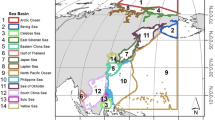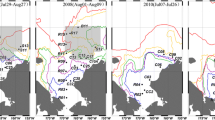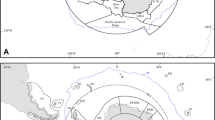Abstract
We examined the taxonomic resolution of zooplankton data required to identify ocean basin scale biogeographic zonation in the Southern Ocean. A 2,154 km transect was completed south of Australia. Sea surface temperature (SST) measured at 1 min intervals showed that seven physical zones were sampled. Zooplankton were collected at a spatial resolution of ~9.2 km with a continuous plankton recorder, identified to the highest possible taxonomic resolution and enumerated. Zooplankton assemblage similarity between samples was calculated using the Bray–Curtis index for the taxonomic levels of species, genus, family, order and class after first log10(x + 1) (LA) and then presence/absence (PA) transformation of abundance data. Although within and between zone sample similarity increased with decreasing taxonomic resolution, for both data transformations, cluster analysis demonstrated that the biogeographic separation of zones remained at all taxonomic levels when using LA data. ANOSIM confirmed this, detecting significant differences in zooplankton assemblage structure between all seven a priori determined physical zones for all taxonomic levels when using the LA data. In the case of the PA data for the complete data set, and both LA and PA data for a crustacean only data set, no significant differences were detected between zooplankton assemblages in the Polar frontal zone (PFZ) and inter-PFZ at any taxonomic level. Loss of information at resolutions below the species level, particularly in the PA data, prevented the separation of some zones. However, the majority of physical zones were biogeographically distinct from species level to class using both LA and PA transformations. Significant relationships between SST and zooplankton community structure, summarised as NMDS scores, at all taxonomic levels, for both LA and PA transformations, and complete and crustacean only data sets, highlighted the biogeographic relevance of low resolution taxonomic data. The retention of biogeographic information in low taxonomic resolution data shows that data sets collected with different taxonomic resolutions may be meaningfully merged for the post hoc generation of Southern Ocean time series.






Similar content being viewed by others
References
Atkinson A, Siegel V, Pakhomov E, Rothery P (2004) Long-term decline in krill stock and increase in salp stock in the Southern ocean. Nature 432:100–103. doi:10.1038/nature02996
Beaugrand G, Reid PC, Ibanez F, Lindley JA, Edwards M (2002) Reorganization of north Atlantic marine copepod biodiversity and climate. Science 296:1692–1694. doi:10.1126/science.1071329
Beaugrand G, Brander KM, Lindley JA, Souissi S, Reid PC (2003) Plankton effect on cod recruitment in the North Sea. Nature 426:661–664. doi:10.1038/nature02164
Belkin IM, Gordon AL (1996) Southern Ocean fronts from the Greenwich meridian to Tasmania. J Geophys Res 101:3675–3696. doi:10.1029/95JC02750
Boltovskoy D (1998) Pelagic biogeography: background, gaps and trends. In: Pierrot-Bults AC (ed) Pelagic biogeography ICoPB II. IOC/UNESCO, Paris, pp 53–64
Boltovskoy D (1999) South Atlantic Zooplankton. Backhuys Publishers, Leiden
Chiba S, Ishimaru T, Hosie GW, Fukuchi M (2001) Spatio-temporal variability of zooplankton community structure off east Antarctica (90° to 160°E). Mar Ecol Prog Ser 216:95–108. doi:10.3354/meps216095
Clarke KR, Warwick RM (1994) Change in marine communities: an approach to statistical analysis and interpretation. Plymouth Marine Laboratory, Plymouth
Edwards M, Richardson AJ (2004) Impact of climate change on pelagic phenology and trophic mismatch. Nature 430:831–884. doi:10.1038/nature02808
Edwards M, John AWG, Hunt HG, Lindley JA (1999) Exceptional influx of oceanic species into the North Sea late 1997. J Mar Biol Assoc UK 79:737–739. doi:10.1017/S0025315498000885
Edwards M, John AWG, Johns DG, Reid PC (2001) Case-history and persistence of non-indigenous diatom Coscinodiscus wailesii in the north-east Atlantic. J Mar Biol Assoc UK 81:207–211
Errhif A, Razouls C, Mayzaud P (1997) Composition and community structure of pelagic copepods in the Indian sector of the Antarctic Ocean during the end of the austral summer. Polar Biol 17:418–430. doi:10.1007/s003000050136
Fransz HG, Gonzalez SR (1997) Latitudinal metazoan plankton zones in the Antarctic Circumpolar Current along 6 degree W during austral spring 1992. Deep Sea Res Part II Top Stud Oceanogr 44:395–414. doi:10.1016/S0967-0645(96)00065-3
Fukuchi F, Tanimura A (1981) Plankton samplings on board Fuji in 1972–1980. JARE Data Rep 60:1–27
Gibbons MJ (1997) Pelagic biogeography of the south Atlantic Ocean. Mar Biol (Berl) 129:757–768. doi:10.1007/s002270050218
Herman AW, Beanlands B, Phillips EF (2004) The next generation of optical plankton counter: the Laser-OPC. J Plant Res 26:1135–1145
Hosie GW (1994) The macrozooplankton communities in the Prydz Bay region, Antarctica. In: El-Sayed SZ (ed) Southern Ocean ecology: the BIOMASS perspective. Cambridge University Press, Cambridge, pp 93–123
Hosie GW, Fukuchi M, Kawaguchi S (2003) Development of the Southern Ocean continuous plankton recorder survey. Prog Oceanogr 58:263–283. doi:10.1016/j.pocean.2003.08.007
Hubold G, Hempel I, Meyer M (1988) Zooplankton communities in the southern Weddell Sea (Antarctica). Polar Biol 8:225–233. doi:10.1007/BF00443454
Hunt BPV, Hosie GW (2005) Zonal structure of zooplankton communities in the Southern Ocean south of Australia: results from a 2150 kilometer continuous plankton recorder transect. Deep Sea Res Part I Oceanogr Res Pap 52:1241–1271. doi:10.1016/j.dsr.2004.11.019
Johns DG, Edwards M, Batten SD (2001) Arctic boreal plankton species in the Northwest Atlantic. Can J Fish Aquat Sci 58:2121–2124. doi:10.1139/cjfas-58-11-2121
Lasiak T (2003) Influence of taxonomic resolution, biological attributes and data transformations on multivariate comparisons of rocky macrofaunal assemblages. Mar Ecol Prog Ser 250:29–34. doi:10.3354/meps250029
Lindley JA, Roskell J, Warner AJ, Halliday NC, Hunt HG, John AWG et al (1990) Doliolids in the German Bight in 1989: evidence for exceptional inflow into the North Sea. J Mar Biol Assoc UK 70:679–682
Mathew KJ, Vincent D (1986) Daily variations in the abundance of zooplankton in the coastal waters of Queen Maud Land, Antarctica during summer 1983–’84. In: Third Indian Ocean Expedition to Antarctica, Scientific Report. Dep Ocean Dev Tech Pub 3, pp 97–108
McGowan JA (1986) The biogeography of pelagic ecosystems. UNESCO Tech Pap Mar Sci 49:191–200
Narayanaswamy BE, Nickell TD, Gage JD (2003) Appropriate levels of taxonomic discrimination in deep-sea studies: species vs family. Mar Ecol Prog Ser 257:59–68. doi:10.3354/meps257059
Olsgard F, Somerfield PJ, Carr MR (1997) Relationships between taxonomic resolution and data transformations in analyses of a macrobenthic community along an established pollution gradient. Mar Ecol Prog Ser 149:173–181. doi:10.3354/meps149173
Orsi AH, Whitworth TIII, Nowlin WD Jr (1995) On the meridional extent and fronts of the Antarctic Circumpolar Current. Deep Sea Res Part I Oceanogr Res Pap 42:641–673. doi:10.1016/0967-0637(95)00021-W
Pakhomov EA, Verheye HM, Atkinson A, Laubscher RK, Taunton Clark J (1997) Structure and grazing impact of the mesozooplankton community during late summer 1994 near South Georgia, Antarctica. Polar Biol 18:180–192. doi:10.1007/s003000050175
Pane L, Feletti M, Francomacaro B, Mariottini GL (2004) Summer coastal zooplankton biomass and copepod community structure near the Italian Terra Nova Base (Terra Nova Bay, Ross Sea, Antarctica). J Plant Res 26:1479–1488
Philippi TE, Dixon PM, Taylor BE (1998) Detecting trends in species composition. Ecol Appl 8:300–308. doi:10.1890/1051-0761(1998)008[0300:DTISC]2.0.CO;2
Reid PC, Surey-Gent SC, Hunt HG, Durrant AE (1992) Thalassiothrix longissima, a possible oceanic indicator species in the North Sea. ICES J Mar Sci 195:268–277
Reid PC, Colebrook JM, Matthews JBL, Aiken J, Continuous Plankton Recorder Team (2003) The continuous plankton recorder: concepts and history, from the plankton indicator to undulating recorders. Prog Oceanogr 58:117–173. doi:10.1016/j.pocean.2003.08.002
Roemmich D, McGowan J (1995) Climatic warming and the decline of zooplankton in the California current. Science 267:1324–1326. doi:10.1126/science.267.5202.1324
Sokolov S, Rintoul SR (2002) Structure of Southern Ocean fronts at 140oE. J Mar Syst 37:151–184. doi:10.1016/S0924-7963(02)00200-2
Somerfield PJ, Clarke KR (1995) Taxonomic levels, in marine community studies, revisited. Mar Ecol Prog Ser 127:113–119. doi:10.3354/meps127113
Takahashi K, Tanimura A, Fukuchi M (1997) Plankton sampling on board Shirase in 1983–1996—NORPAC standard net samples. JARE Data Rep 28:1–35 (Mar Biol)
Takahashi K, Tanimura A, Fukuchi M (1998) Long-term observation of zooplankton biomass in the Indian Ocean sector of the Southern Ocean. Proceedings of the International Symposium on Environmental Research in Antarctica. Mem Nat Inst Polar Res 52: 209–219
Tarling GA, Ward P, Sheader M, Williams JA, Symon C (1995) Distribution patterns of macrozooplankton assemblages in the southwest Atlantic. Mar Ecol Prog Ser 120:29–40. doi:10.3354/meps120029
Voronina NM, Kosobokova KN, Pakhomov EA (1994) Composition and biomass of summer metazoan plankton in the 0–200 m layer of the Atlantic sector of the Antarctic. Polar Biol 14:91–95. doi:10.1007/BF00234970
Ward P, Grant S, Brandon M, Siegel V, Sushin V, Loeb V et al (2004) Mesozooplankton community structure in the Scotia Sea during the CCAMLR 2000 survey: January–February 2000. Deep Sea Res Part II Top Stud Oceanogr 51:1351–1367
Warwick RM (1988) Effects on community structure of a pollution gradient—summary. Mar Ecol Prog Ser 46:207–211. doi:10.3354/meps046207
Warwick RM (1993) Environmental impact studies on marine communities: pragmatical considerations. Aust J Ecol 18:63–80. doi:10.1111/j.1442-9993.1993.tb00435.x
Acknowledgments
We would like to thank Kunio Takahashi, and the Master and crew of the RV ‘‘Tangaroa’’ for collecting the CPR samples, Tsuneo Odate for making available the underway data, and the Australian government for funding this research project.
Author information
Authors and Affiliations
Corresponding author
Additional information
Communicated by S.A. Poulet.
Rights and permissions
About this article
Cite this article
Hunt, B.P.V., Hosie, G.W. Southern Ocean biogeography and taxonomic resolution: what’s in the name?. Mar Biol 155, 191–203 (2008). https://doi.org/10.1007/s00227-008-1017-9
Received:
Accepted:
Published:
Issue Date:
DOI: https://doi.org/10.1007/s00227-008-1017-9




